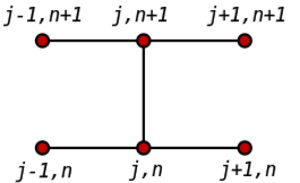Crank–Nicolson method (nonfiction)
In numerical analysis, the Crank–Nicolson method is a finite difference method used for numerically solving the heat equation and similar partial differential equations.
Description
It is a second-order method in time, it is implicit in time and can be written as an implicit Runge–Kutta method, and it is numerically stable.
The method was developed by John Crank and Phyllis Nicolson in the mid 20th century.
For diffusion equations (and many other equations), it can be shown the Crank–Nicolson method is unconditionally stable.
However, the approximate solutions can still contain (decaying) spurious oscillations if the ratio of time step Δt times the thermal diffusivity to the square of space step, Δx2, is large (typically larger than 1/2 per Von Neumann stability analysis).
For this reason, whenever large time steps or high spatial resolution is necessary, the less accurate backward Euler method is often used, which is both stable and immune to oscillations.
Nonfiction cross reference
Fiction cross reference
External links
- Crank–Nicolson method @ wiki.karljones.com
- Crank–Nicolson method

